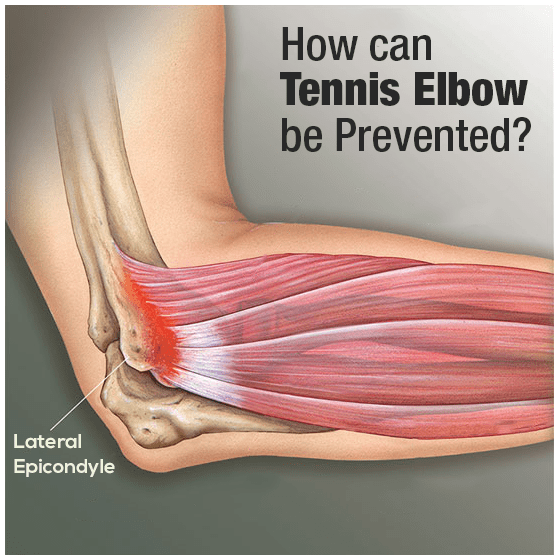Tennis elbow is a common condition that affects individuals of all ages and occupations and not just tennis players. Despite its name, this injury can occur due to repetitive arm motions involved in various activities, leading to pain and discomfort. This condition, which is caused by pain and discomfort on the elbow’s outside, may cause issues with everyday tasks. It can develop as a result of repetitive actions performed in jobs or activities like painting, plumbing, carpentry, gardening and typing. It usually happens between the age of 30-50 years.
In this blog, we will explore the causes, symptoms and tennis elbow treatment. We will also discuss how Prolotherapy treatment and EPAT therapy can help improve the pain of the elbow.
Understanding Tennis elbow
Also known as lateral epicondylitis, is a form of tendinitis that affects the tendons on the outer side of the elbow. These tendons connect the muscles of the forearm to the bone and are responsible for the extension of the wrist and fingers. The repeated stress and overuse of these tendons can result in micro-tears and inflammation.
What causes Tennis elbow?
- Repetitive Arm Movements: Engaging in activities that involve repetitive arm movements, such as tennis, golf, painting, plumbing or cooking can strain the tendons in the forearm.
- Incorrect Technique: Poor form or incorrect technique while performing certain sports or activities can place excessive stress on the tendons.
- Occupational Factors: Certain occupations, such as carpentry, plumbing or computer work, require repetitive arm movements, increasing the likelihood of developing the condition.
Symptoms of Tennis elbow
- Elbow Pain: The primary symptom is pain on the outer side of the elbow. The pain may gradually worsen over time and can be aggravated by gripping or lifting objects.
- Weakness and Stiffness: Individuals may experience weakness in their grip and difficulties in performing everyday tasks that require wrist and hand movements.
- Radiating Pain: In some cases, the pain may radiate from the elbow to the forearm and wrist.
Treatment options
- Rest and Modification of Activities: Resting the affected arm and avoiding activities that exacerbate the pain is essential for recovery. Modifying techniques and using ergonomic equipment can also help reduce strain on the tendons.
- Physical Therapy: A physical therapist can provide specific exercises and techniques to strengthen the forearm muscles and improve flexibility, reducing the symptoms of tennis elbow.
- Pain Medication: Over-the-counter pain relievers, such as nonsteroidal anti-inflammatory drugs (NSAIDs), can help alleviate pain and reduce inflammation.
- Corticosteroid Injections: In severe cases, corticosteroid injections may be recommended to reduce inflammation and provide temporary pain relief.
Surgery for Tennis elbow
Surgery for tennis elbow often includes releasing or repairing the injured tendons in addition to removing the damaged tissue. It can address the root cause while may be effective in some cases, but not for everyone. Surgery has the ability to reduce chronic pain, restore functionality and allow patients to resume their regular activities and sports.
While some people with serious or ongoing conditions may benefit from surgery, it must be used as a last alternative. Consulting with professional healthcare can help you find a better treatment option for you.
The reason why surgery can’t be a good option for you
1. Although, it can lead to pain and can take a longer recovery period.
2. High chances of infection on the surgery part which delays the healing process.
3. There may be limited mobility and strength after going through surgery.
4. Surgery may not guarantee full improvement of the elbow.
So, what treatment option may be useful? Although, there are various treatments one can look out for. Without requiring surgery or other procedures, you can opt for conservative treatments that include physical therapy, rest and the use of shockwave therapies that promote natural healing and reduce symptoms.
Prolotherapy treatment for Tennis Elbow
Prolotherapy is a non-surgical treatment that offers promising results for individuals. It involves injecting a solution, dextrose-based solution, into the affected area around the elbow joint. Prolotherapy causes an inflammatory reaction that promotes the creation of new tissue, which strengthens and supports the injured tendons and ligaments surrounding the elbow.
Over time, the new collagen strengthens the weakened tissues, less pain and improves function. It can effectively enhance the healing process and restore normal function, allowing individuals to return to their favourite activities pain-free.

Why Prolotherapy is the best option for Tennis Elbow?
Prolotherapy is also a form of treatment that can be performed in a clinic. To get the best benefits, it usually takes a series of injections placed over a few weeks or months. It is an effective alternative to surgery for people who want to avoid surgery or who have had poor results from various non-surgical treatments. It usually requires some sessions for the treatment.
EPAT Therapy for Tennis Elbow
EPAT therapy is also a non-invasive treatment method that uses acoustic pressure waves to stimulate the affected area. These waves penetrate deep into the tissues, promoting increased blood circulation and the formation of new blood vessels. It is a non-surgical method that doesn’t require anesthesia or incisors.
EPAT is known for its high success rate. This effective and convenient method can provide long-lasting results, which help improve the pain in the elbow.
Conclusion
Tennis elbow is a difficult condition that needs time, effort and a good strategy for its treatment. The Prolotherapy clinic’s approach focuses on a combination of non-surgical methods, including physical therapy, pain management and regenerative injection method. By utilizing therapies such as platelet-rich plasma (PRP) injections and stem cell therapy, it aims to accelerate the healing process and restore optimal function in the affected elbow.
Dr. Vikram Rajguru’s patient-centered approach ensures that each individual receives personalized care and attention throughout their treatment journey. He prioritizes patient education, providing comprehensive guidance on preventive measures and lifestyle modifications to avoid recurring of tennis elbow.


